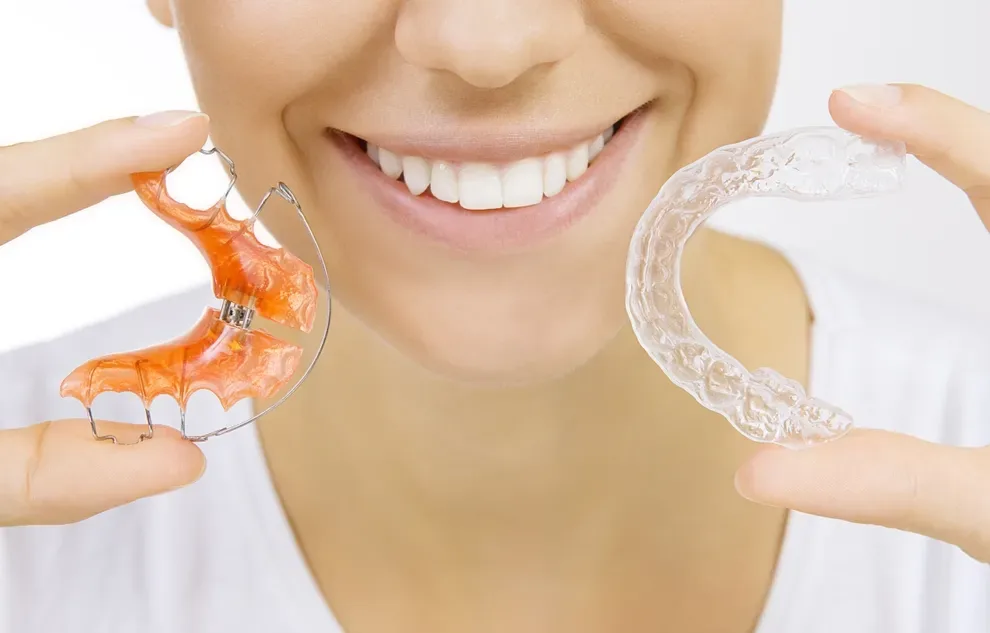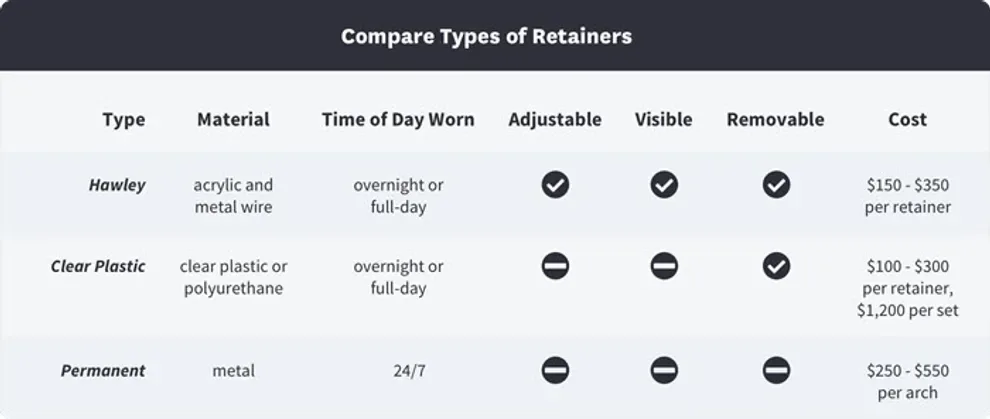Types of Retainers

Table of Contents
- Types of Retainers
- Retainer Basics
- How the Retainer Process Works
- What Do Retainers Look Like?
- Care for Your Retainers
A retainer is a device that’s custom-made to keep teeth in place after orthodontic treatment. It “retains” the new corrected teeth placement and bite. Most retainers are made of metal and plastic.
There are three main types of retainers. Permanent retainers are bonded to the back of your teeth. Hawley retainers are the “traditional” type of retainer, with a wire that runs along the front of your teeth and connects to a plastic or ceramic base that sits on the roof of your mouth. A plastic retainer is clear and fits over your teeth.
Note: Essix retainers were the first popular clear plastic retainer. Today they are one of many types or brands of plastic retainers. Still, some people refer to all plastic retainers as Essix retainers.

Comparing the Different Types of Retainers
When considering which type of retainer to choose, there are a few factors to consider, such as these:
The type of orthodontic treatment you completed: If you completed a clear aligner treatment, for example, your aligner provider might offer a retainer that’s very similar to the style you wore throughout treatment, so you’ll already be used to it. If you completed braces treatment with an orthodontist, they may recommend a specific type of retainer for your treatment plan.
Durability: Some retainers are more durable than others. If you know that your lifestyle requires a more drop-proof retainer, you may want to choose one that’s not fragile.
Maintenance: All removable retainers need to be cleaned daily to avoid bacteria buildup that could cause problems like bad breath and tooth decay. Permanent retainers stay in the mouth but could make it harder to clean your teeth and create hidden “pockets” for bacteria like plaque to accumulate in. You have to be diligent about your oral care.
Visibility: Clear retainers and permanent retainers are less noticeable, while traditional Hawley retainers feature a wire across the teeth.
Cost and availability: Before choosing a retainer, look into how much it will cost to replace and how long it will take to get another one. In the event that you do lose or damage your retainer, you don’t want to be stuck paying a high cost or waiting for a long time. Waiting could put your teeth at risk of shifting.
What Do Retainers Look Like?
Permanent retainers are made of metal, but they are attached to the back of the teeth, so they are nearly invisible.
Clear plastic retainers are virtually invisible, as they are clear and fit over the teeth.
Hawley retainers are the classic image you may have in mind when you think of a retainer. A plastic plate is molded to fit your mouth, and that base is connected to a wire that goes over your teeth (on the front).
Retainer Basics: Understanding the Types of Retainers
There are three basic types of retainers that may be recommended after your orthodontic treatment:
This type of device is made from acrylic or plastic with a metal wire that goes over the front of the teeth. This retainer holds teeth in a specific position, and it’s usually worn overnight. The consistent pressure keeps your teeth from shifting out of alignment.
A removable Hawley retainer can cost between $150 and $350. With removable retainers, you may not need to get more than one or two during your full course of treatment. Your dental insurance may cover some or all of the cost.
Pros of Removable Hawley Retainers
Durable
Affordable
Easy to clean
Removable for convenience
Cons of Removable Hawley Retainers
Highly visible
Top plate may affect speech
These types of retainers look much like aligners. They are clear plastic that fully surrounds the teeth. You can also get retainers made from plastic or polyurethane after you have other orthodontic treatment like braces.
These retainers are easy to clean and remove, just like metal and acrylic removable retainers. They are typically less visible, but they are more expensive than a Hawley retainer.
Plastic or polyurethane retainers are not as sturdy as metal/acrylic retainers, so you will probably replace them once a year if your course of treatment lasts longer than 12 months.
You must clean plastic retainers more thoroughly than Hawley retainers. While a plastic retainer may cost about the same as a standard removable retainer — between $100 and $300 — some options can cost up to $1,200 for a set.
Plastic retainers are easier to damage, as the material may be thinner than traditional retainers. They are not adjustable on their own, so an orthodontist can’t tighten them. Instead, a new retainer will need to be made.
Pros of Clear Plastic Retainers
Comfortable
Invisible
Removable for convenience
Cons of Clear Plastic Retainers
Harder to clean
Not adjustable (if teeth shift, a new set will need to be made)
Easier to lose
Permanent retainers are generally made of metal. A thin wire is bonded to the back of the teeth and can only be removed by an orthodontist.
While permanent retainers cost more than a Hawley retainer or a clear plastic retainer — around $250 to $550 per arch, either top or bottom — your dental insurance may be more likely to cover some of the cost of this preventative treatment.
Permanent retainers are harder to clean since they remain in your mouth. You will need to follow specific instructions from your orthodontist on maintaining oral health while you have this retainer in place, and that includes going to all your appointments, which may include adjustments and tightening.
Pros of Permanent Retainers
Low maintenance
Hard to damage
Not visible
Cons of Permanent Retainers
Not removable
Requires diligent oral hygiene
May create pockets between device and teeth where bacteria and food particles can accumulate, resulting in decay or bad breath
How Long Do Clear Plastic Retainers Last?
Clear plastic retainers are strong enough to keep your teeth in place, but they don’t last as long as their traditional counterparts. In one study of clear plastic retainers in children, researchers said clear versions broke more often than standard types. Researchers also said they told their patients to replace their retainers annually, as they become thinner and discolored.
You have a lot of control over how long clear plastic retainers last. For example, researchers say these devices often fail due to the following preventable problems:
Staining: To prevent this problem, don’t eat or drink anything while your trays are in place, and don’t use colorful cleaners (like mouthwash) to rinse them.
Manufacture: Many different companies build plastic retainers, and some use materials that aren’t as strong as others. Ensure your doctor or aligner company uses one that lasts.
Grinding: If you know you grind your teeth, talk with your doctor. Pushing your teeth together can subject your retainers to too much pressure. A Hawley retainer doesn’t cover flat surfaces of your teeth, so it might be a better choice for you.
How Much Do Clear Plastic Retainers Cost?
Consumers say a clear plastic retainer typically costs $300 to $750, and some versions are auto-renewing. Every few months, you’ll get a new set in the mail to wear to keep your teeth in place.
Your clear plastic retainer cost might include the following:
Creating impressions of your teeth
Materials used to make the retainers
Manufacturing time
Doctor expertise
These same steps are required for other types of retainers, but those versions can be slightly less expensive. A Hawley retainer can cost as little as $150 for one tray, and a permanent version could cost $250 (and last a lifetime).
Many insurance companies cover the cost of retainers. Cigna, for example, considers retainers as part of covered orthodontic services within their plans.
However, your insurance company might limit how much you can spend on retainers, and if you need to replace them, you might be forced to cover the cost yourself. It’s best to ask questions before you order them to avoid any nasty surprises (and bills).
How the Retainer Process Works
Because teeth shift, any orthodontic treatment will require the use of a retainer, especially immediately after treatment, when the mouth and jaw are still getting accustomed to a new bite and tooth placements.
Immediately after your orthodontic treatment, if you’ve chosen a removable retainer, you’ll likely have to wear your retainer on a full-time basis for up to 6 months or even a year. You’ll probably transition to part-time wear after that. To ensure your teeth stay in alignment, you may wear your retainer at night indefinitely.
Permanent retainers are often worn for years. After they’re removed, part-time use of a removable retainer will likely be recommended.
No matter what type of retainer you get, it is important to do the following:
Clean it by following the cleaning instructions provided.
Keep it safe if it is removable, which means keeping it in its case in a safe location.
Stick to scheduled orthodontic checkups if you have completed a course of braces. Follow the prescribed guidelines for wearing your retainer if you have completed an aligner course of treatment.
Get in touch with your treatment team immediately if something does not feel right.
Let your treatment team know if your retainer is damaged or isn’t fitting properly, so you can get a new one.
Choosing Between Types of Retainers: A Guide
Most orthodontic professionals choose retainers for their patients. As researchers explain, choosing the right product is an “essential consideration” for these professionals, and they do their best to match the right device to the right patient.
While you’re not required to pick a product, it’s smart to understand why your doctor might choose one type of retainer over the other. The following factors are critical:
Compliance
Some types of retainers are removable, so you can take them out to clean your teeth and eat your meals. However, some people won’t put their retainers back in when they take them out.
If you’ve consistently skipped appointments, delayed your treatment, or otherwise demonstrated that you won’t stick to the program, a permanent retainer could be a good choice.
Oral Health
Removable retainers allow you to clean between your teeth with floss. Permanent retainers block that access, which could allow bacteria to build up and thrive. If you’ve struggled with poor oral health in the past, your doctor won’t want to exacerbate that problem with a permanent retainer.
Coverage
Some insurance companies restrict their payouts for retainers. For example, your plan might pay for the first device after your treatment ends, but you’re on the hook for any replacements due to breakage. If your coverage is limited and you’re on a budget, your doctor may look for the most cost-efficient way to protect your smile.
Adjusting to Your Retainers
A properly fitting retainer should fit snugly on your teeth without causing discomfort. However, you might still notice it’s there.
You should follow your dental professional’s instructions about wearing your retainer—even if it feels strange. Try not to focus on how it feels or how it looks inside your mouth. Instead, focus on how straight and clean your teeth feel.
You’ll adjust to life with a retainer in no time. And if you’re still uncomfortable after a week or two, reach out to your orthodontist, dentist, or aligner treatment company, and ask for adjustment help.
